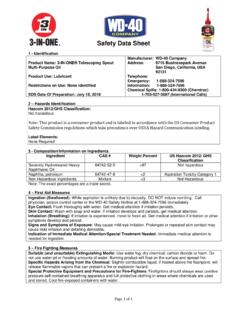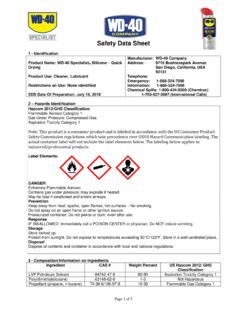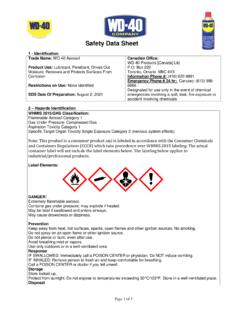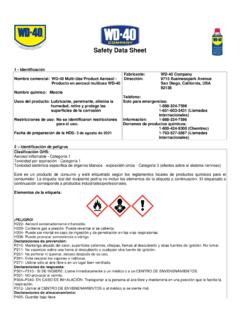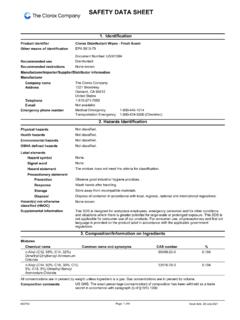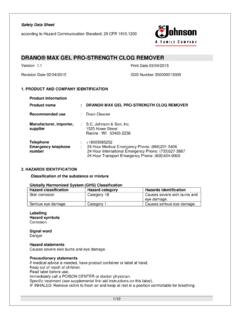Transcription of Material Safety Data Sheet (MSDS) - WD-40
1 Page 1 of 4 Safety data Sheet 1 - Chemical Product and Company Identification Manufacturer: WD-40 Company Address: 9715 Businesspark Ave San Diego, CA , USA Post code: 92131 Telephone: +1-800-448-9340 +1-858-251-5600 24 Hour Emergency Phone Number: 1-888-324-7596 (PROSAR) Chemical Spills: 1-800-424-9300 (Chemtrec) 1-703-527-3887 (International Calls) Chemical Name: Organic Mixture Trade Name: WD-40 Aerosol Product Use: Lubricant, Penetrant, Drives Out Moisture, Removes and Protects Surfaces From Corrosion SDS Date Of Preparation: April 12, 2018 2 Hazards Identification GHS Classification: Flammable Aerosol Category 1 Aspiration Toxicity Category 1 DANGER! H222 Extremely Flammable Aerosol. H229 Pressurized container: may burst if heated. H304 May be fatal if swallowed and enters airways. Prevention P210 Keep away from heat, sparks, open flames, and hot surfaces. No smoking. P211 Do not spray on an open flame or other ignition source.
2 P251 Do not pierce or burn, even after use. Response P301+P310 IF SWALLOWED: Immediately call a POISON CENTER or doctor. P331 Do NOT induce vomiting. Storage P405 Store locked up. P410+P412 Protect from sunlight. Do not expose to temperatures exceeding 50 C/122 F. disposal P501 Dispose of contents and container in accordance with local and national regulations. 3 - Composition/Information on Ingredients Ingredient CAS # Weight Percent GHS Classification Distillates (petroleum), hydrotreated light 64742-47-8 50-70 Flammable Liquid Category 4 Aspiration Toxicity Category 1 Non-Hazardous Ingredients Mixture 30-50 Not Hazardous Carbon Dioxide 124-38-9 2-3 Gas Under Pressure Compressed Gas Page 2 of 4 4 First Aid Measures Ingestion (Swallowed): Aspiration Hazard. DO NOT induce vomiting. Call physician, poison control center or the WD-40 Safety Hotline at 1-888-324-7596 immediately. 24 hours Hotline of Emergency Service for Chemical Incident in China: 0532-83889090.
3 Eye Contact: Flush thoroughly with water. Remove contact lenses if present after the first 5 minutes and continue flushing for several more minutes. Get medical attention if irritation persists. Skin Contact: Wash with soap and water. If irritation develops and persists, get medical attention. Inhalation (Breathing): If irritation is experienced, move to fresh air. Get medical attention if irritation or other symptoms develop and persist. Most Important Symptoms (acute and delayed): May cause eye irritation. Skin contact may cause drying of the skin. Inhalation of mists may cause coughing, headache and dizziness. Harmful or fatal if swallowed. If swallowed, may be aspirated and cause lung damage. Indication of Immediate Medical Attention or Special Treatment: Immediate medical attention is required for ingestion. 5 Fire Fighting Measures Extinguishing Media: Use water fog, dry chemical, carbon dioxide or foam.
4 Do not use water jet or flooding amounts of water. Burning product will float on the surface and spread fire. Special Fire Fighting Procedures: Firefighters should always wear positive pressure self-contained breathing apparatus and full protective clothing. Cool fire-exposed containers with water. Use shielding to protect against bursting containers. Unusual Fire and Explosion Hazards: Contents under pressure. Extremely flammable aerosol. Keep away from ignition sources and open flames. Exposure of containers to extreme heat and flames can cause them to rupture often with violent force. Vapors can cause a flash fire. Vapors are heavier than air and may travel along surfaces to remote ignition sources and flash back. A vapor and air mixture can create an explosion hazard in confined spaces. 6 Accidental Release Measures Personal Precautions, Protective Equipment and Emergency Procedures: Eliminate all sources of ignition and ventilate area.
5 Wear appropriate protective clothing (see Section 8). Environmental Precautions: Report spills to authorities as required. Methods and Materials for Containment/Cleanup: Leaking cans should be placed in a plastic bag or open pail until the pressure has dissipated. Contain and collect liquid with an inert absorbent and place in a container for disposal . Clean spill area thoroughly. Report spills to authorities as required. 7 Handling and Storage Precautions for Safe Handling: Avoid contact with eyes. Avoid prolonged contact with skin. Avoid breathing vapors or aerosols. Use only with adequate ventilation. Keep away from heat, sparks, pilot lights, hot surfaces and open flames. Unplug electrical tools, motors and appliances before spraying or bringing the can near any source of electricity. Electricity can burn a hole in the can and cause contents to burst into flames. To avoid serious burn injury, do not let the can touch battery terminals, electrical connections on motors or appliances or any other source of electricity.
6 Wash thoroughly with soap and water after handling. Keep containers closed when not in use. Keep out of the reach of children. Do not puncture, crush or incinerate containers, even when empty. Conditions for Safe Storage, including any incompatibilities: Store in a cool, well-ventilated area, away from incompatible materials. Do not store in direct sunlight or above 120 F. Store away from oxidizers. 8 Exposure Controls/Personal Protection Chemical Occupational Exposure Limits Distillates (petroleum), hydrotreated light 1200 mg/m3 TWA (manufacturer recommended) Non-Hazardous Ingredients None Established Carbon Dioxide 5000 ppm TWA, 30,000 ppm STEL ACGIH TLV 9000 mg/m3 TWA, 18000 mg/m3 STEL PC OEL Page 3 of 4 The Following Controls are Recommended for normal Consumer Use of this Product Engineering Controls: Use in a well-ventilated area. Personal Protection: Eye Protection: Avoid eye contact. Always spray away from your face.
7 Skin Protection: Avoid prolonged skin contact. Chemical resistant gloves recommended for operations where skin contact is likely. Respiratory Protection: None needed for normal use with adequate ventilation. For Bulk Processing or Workplace Use the Following Controls are Recommended Engineering Controls: Use adequate general and local exhaust ventilation to maintain exposure levels below that occupational exposure limits. Personal Protection: Eye Protection: Safety goggles recommended where eye contact is possible. Skin Protection: Wear chemical resistant gloves. Respiratory Protection: None required if ventilation is adequate. If the occupational exposure limits are exceeded, wear a NIOSH approved respirator. Respirator selection and use should be based on contaminant type, form and concentration. Follow OSHA , ANSI and good Industrial Hygiene practice. Work/Hygiene Practices: Wash with soap and water after handling.
8 9 Physical and Chemical Properties Appearance: Light amber liquid Flammable Limits: LEL: UEL: (Distillates (petroleum), hydrotreated light) Odor: Mild petroleum odor Vapor Pressure: kPa @ 20 C Odor Threshold: Not established Vapor Density: pH: Not established Relative Density: Not established Melting/Freezing Point: Not established Solubility(ies): Insoluble in water Boiling Point/Range: 147-663 C Partition Coefficient; n-octanol/water: Not established Flash Point: 175 F ( C) Auto ignition Temperature: 239 C Evaporation Rate: Not established Decomposition Temperature: Not established Flammability (solid, gas): Flammable Aerosol Viscosity: mm2/sec@40 C VOC: 533 grams/liter (65%) Pour Point: -42 C 10 Stability and Reactivity Reactivity: Not reactive under normal conditions Chemical Stability: Stable Possibility of Hazardous Reactions: Hazardous polymerization will not occur. Conditions to Avoid: Avoid heat, sparks, flames and other sources of ignition.
9 Do not puncture or incinerate containers. Incompatible Materials: Strong oxidizing agents. Hazardous Decomposition Products: Carbon monoxide and carbon dioxide. 11 Toxicological Information Symptoms of Overexposure: Inhalation: High concentrations may cause nasal and respiratory irritation and central nervous system effects such as headache, dizziness and nausea. Intentional abuse may be harmful or fatal. Skin Contact: Prolonged and/or repeated contact may produce mild irritation and defatting with possible dermatitis. Eye Contact: Contact may be irritating to eyes. May cause redness and tearing. Ingestion: This product has low oral toxicity. Swallowing may cause gastrointestinal irritation, nausea, vomiting and diarrhea. This product is an aspiration hazard. If swallowed, can enter the lungs and may cause chemical pneumonitis, severe lung damage and death. Page 4 of 4 Chronic Effects: None expected. Carcinogen Status: None of the components are listed as a carcinogen or suspect carcinogen by IARC, NTP, ACGIH or OSHA.
10 Reproductive Toxicity: None of the components is considered a reproductive hazard. Numerical Measures of Toxicity: Acute Toxicity Estimates: Oral > 5,000 mg/kg; Dermal >2,000 mg/kg based on an assessment of the ingredients. This product is not classified as toxic by established criteria. It is an aspiration hazard. 12 Ecological Information Ecotoxicity: No specific aquatic toxicity data is currently available; however components of this product are not expected to be harmful to aquatic organisms. If applied to leaves may kill grasses and small plants by interfering with respiration and transpiration. This product is not toxic to fish but may coat gill structures resulting in suffocation. Persistence and Degradability: Components are expected to be biodegradable. Bioaccumulative Potential: Bioaccumulation is not expected based on an assessment of the ingredients. Mobility in Soil: No data available. Other Adverse Effects: None Known 13 - disposal Considerations Aerosol containers should not be punctured, compacted in home trash compactors or incinerated.



